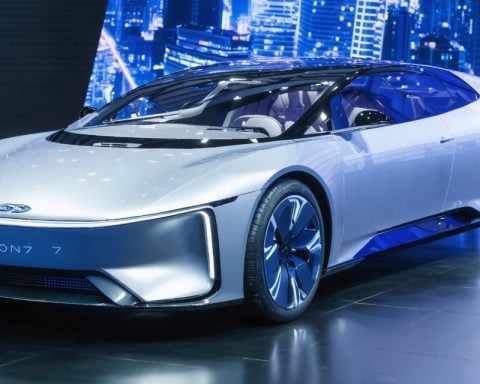General Motors (GM) is making a powerful move in the EV market, setting its sights on affordability and innovation. As GM prepares to launch a new generation of electric vehicles (EVs), its strategy is pivoting towards creating an efficient domestic battery supply chain, essential for lowering costs and boosting profitability.
With Kurt Kelty, a former Tesla executive known for his pivotal work on battery technology, leading the charge, GM is aiming to transform how it sources and manufactures batteries. Kelty emphasizes the necessity of vertically integrating the supply chain within North America, which could significantly reduce costs associated with shipping and quality control. This is alongside investments exceeding $1 billion in lithium and graphite production, crucial components for batteries.
As GM unveils its revamped lineup, including the affordable Equinox EV and a new version of the Bolt, which is expected to start around $30,000, the company is poised for remarkable growth. The focus on price competitiveness ensures that new buyers can enter the EV market without breaking the bank.
Experts note that pricing below $35,000 can convert potential buyers from skeptics to enthusiastic customers. As GM amplifies its commitment to affordability and range in new models, the automotive landscape may be ripe for significant change.
In this evolving scenario, GM is not just challenging Tesla; it’s redefining the future of electric mobility. Will this strategy succeed in capturing market share, or will it be a gamble too big to take?
Implications of GM’s Electric Vehicle Strategy
The shift towards affordable electric vehicles (EVs) by General Motors (GM) carries profound ramifications for society, culture, and the global economy. As GM positions itself as a formidable player in the EV market, the broader implications on consumer behavior cannot be understated. By making EVs more accessible with price points targeted below $35,000, GM is not only appealing to budget-conscious consumers but also potentially reshaping public attitudes towards electric mobility.
This democratization of EV technology could lead to a significant increase in market adoption, accelerating the transition from fossil fuel dependency. The more vehicles that transition to electric, the greater the potential for reduced greenhouse gas emissions—a critical factor in addressing climate change. Furthermore, GM’s commitment to building a domestic battery supply chain could stimulate the U.S. economy. By investing in local production, GM is likely to create jobs and foster a competitive manufacturing sector, which may have ripple effects across various industries reliant on advanced materials and technology.
Environmentally, this shift toward electric vehicles may alleviate some of the adverse effects of mining practices and energy consumption associated with traditional automotive manufacturing. However, it also raises concerns about the sustainability of the supply chain for critical minerals like lithium, necessitating a focus on responsible sourcing practices.
Looking ahead, if GM’s strategy succeeds in capturing significant market share, it could spark a new trend among automakers prioritizing affordability and sustainability. This may compel competitors to rethink their pricing and technology strategies, leading to innovation and competition that benefits consumers globally. Ultimately, GM’s bet on affordability in the EV landscape may well dictate the pace and trajectory of the automotive industry’s evolution in the years to come.
GM’s Bold Strategy: Affordable Electric Vehicles and a Sustainable Future
General Motors’ Vision for the EV Market
General Motors (GM) is relentlessly pursuing a transformative strategy in the electric vehicle (EV) sector that emphasizes both affordability and sustainability. As the company prepares to roll out a new generation of EVs, it is focusing on creating an efficient domestic battery supply chain that promises to reduce costs and enhance profitability.
Leadership and Innovations in Battery Technology
Under the leadership of Kurt Kelty, a former Tesla executive renowned for his expertise in battery technology, GM is spearheading changes in how it sources and manufactures batteries. Kelty advocates for the vertical integration of the supply chain within North America, which has the potential to lower transportation costs, streamline quality control, and ultimately reduce the overall price of EVs.
To support this transition, GM is making substantial investments exceeding $1 billion in lithium and graphite production. These materials are essential for battery manufacturing, and by bringing more of this production in-house, GM aims to fortify its supply chain against global disruptions.
Affordable EV Models on the Horizon
GM is set to unveil its new lineup, featuring models such as the Equinox EV and a revamped version of the Bolt. The new Bolt is expected to be competitively priced at around $30,000, a pivotal move to attract budget-conscious consumers. Analysts argue that pricing EVs below $35,000 could sway many potential buyers from skepticism to enthusiasm, making electric mobility more accessible than ever.
Market Trends and Buyer Insights
With the rising interest in EVs, industry experts highlight that affordability and impressive range are critical factors driving consumer decisions. As the average prices of traditional vehicles rise, the demand for lower-priced electric options is likely to increase. By providing cost-effective EVs, GM is poised to capture a significant share of the expanding market.
Pros and Cons of GM’s New Strategy
Pros:
– Affordability: Targeting a price point around $30,000 attracts mainstream buyers.
– Sustainability: Investments in domestic battery production can reduce carbon footprints associated with shipping.
– Innovation: Focusing on battery technology could enhance vehicle performance and ownership experience.
Cons:
– Market Competition: GM faces stiff competition from established players like Tesla and new entrants.
– Supply Chain Risks: While vertical integration offers advantages, it also involves risks if suppliers encounter issues.
– Consumer Reluctance: Overcoming skepticism about EV performance and infrastructure remains a challenge.
Future Predictions and Market Dynamics
As GM asserts its presence in the EV landscape, industry predictions suggest that the company’s commitment to affordable pricing and robust battery technology could redefine consumer attitudes toward electric vehicles. If GM successfully captures the budget-conscious segment, it will not only elevate its market share but also encourage a broader transition to electric mobility.
For further developments on General Motors and their innovative strategies in the automotive industry, visit GM’s official page.












